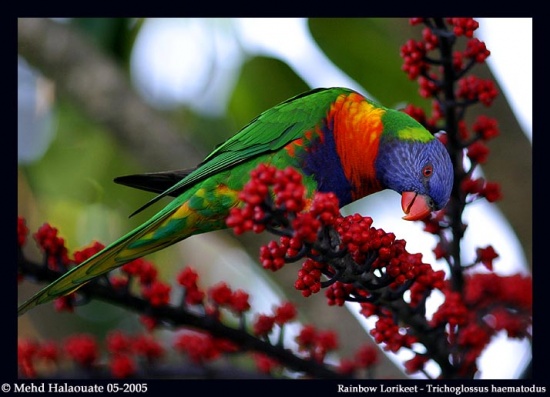- Trichoglossus haematodus
Includes: Biak Lorikeet; Sunset Lorikeet; Leaf Lorikeet, Marigold Lorikeet; Coconut Lorikeet
Identification
The Rainbow Lorikeet is up to about 14 inches (35 cm) long. They weigh about 5 ounces (133 grams). These parrots have brightly-colored red, green, blue, yellow, and orange feathers; the curved bill is red. The males and females are hard to distinguish.
Distribution
Found from Bali eastwards over the Lesser Sundas to New Guinea and adjacent islands to eastern and south-eastern Australia.
Taxonomy
Subspecies[1]
About 19 subspecies are recognized:
- T. h. mitchellii: Bali and Lombok
- T. h. forsteni: Sumbawa (Lesser Sundas)
- T. h. djampeanus: Tanahjampea Island (Flores Sea)
- T. h. stresemanni: Kalaotoa Island (Flores Sea)
- T. h. fortis: Sumba (Lesser Sundas)
- T. h. weberi: Flores (Lesser Sundas)
- T. h. capistratus: Timor (Lesser Sundas)
- T. h. flavotectus: Eastern Lesser Sundas (Wetar and Romang)
- T. h. rosenbergii: Biak Island (off northern New Guinea)
- T. h. intermedius: Northern New Guinea (Sepik River to Astrolabe Bay) and Manam Island
- T. h. haematodus: Southern Moluccas, western Papuan islands and western New Guinea
- T. h. nigrogularis: Eastern Kai Islands, Aru Islands and southern New Guinea
- T. h. brooki: Known from two cage birds from Trangan Island (Aru Islands)
- T. h. micropteryx: New Guinea east of Huon Peninsula; Kimuta and adjacent islands
- T. h. nesophilus: Admiralty Islands (Ninigo and Hermit groups)
- T. h. flavicans: New Hanover and Admiralty Islands
- T. h. massena: Bismarck Archipelago, Solomon Islands and Vanuatu
- T. h. deplanchii: New Caledonia and Loyalty Islands
- T. h.s moluccanus: Eastern and south-eastern Australia (Cape York to Eyre Peninsula, South Australia)
The Red-collared Lorikeet is sometimes considered to be a subspecies of this species. Up to 5 species are sometimes split from this species.
Habitat
The prefered habitat is coastal forests as well as urban gardens.
Behaviour
Noisy flocks of up to several hundred may congregate in flowering trees to feed and roost, at times in the company of Scaly-breasted Lorikeets.
Breeding
Breeding in the wild is from August to January. There are 2 to 3 white eggs in each clutch (a set of eggs laid in one nesting period). The eggs are laid in a tree cavity high above the ground. The female incubates the eggs for 25-26 days, and the male feeds her. Both parents will feed the chicks.
References
- Clements, JF. 2009. The Clements Checklist of Birds of the World. 6th ed., with updates to December 2009. Ithaca: Cornell Univ. Press. ISBN 978-0801445019.
Recommended Citation
- BirdForum Opus contributors. (2024) Rainbow Lorikeet. In: BirdForum, the forum for wild birds and birding. Retrieved 16 May 2024 from https://www.birdforum.net/opus/Rainbow_Lorikeet




